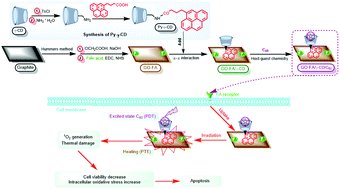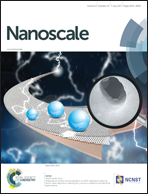Fabrication of a graphene/C60 nanohybrid via γ-cyclodextrin host–guest chemistry for photodynamic and photothermal therapy†
Abstract
The wonderful chemical structures and characteristics of low-dimensional carbon materials have exciting applications in life sciences. In the present study, we developed a facile strategy to conjugate C60 with graphene via host–guest chemistry for targeted phototherapy. A versatile carrier based on folic acid-functionalized graphene (GO-FA) and comprising γ-cyclodextrin (γ-CD) at its surface was assembled via π–π interaction, creating hybrid structures with drug storage and tumor targeting properties. This γ-CD-modified graphene (GO-FA/Py-γ-CD) is capable of hosting pristine C60 molecules for the fabrication of a GO-FA/Py-γ-CD/C60 nanohybrid. The hybridization of GO-FA, γ-CD, and C60 hinders the aggregation of C60, promotes cellular uptake, enhances light absorption, and finally demonstrates enhanced phototherapy effects of GO-FA/Py-γ-CD/C60. Under Xe lamp irradiation (2 W cm−2) for 4 min, GO-FA/Py-γ-CD/C60 simultaneously causes heating and intracellular ROS production, which further significantly reduces the cell viability to 16.2% at low content of loading (30 μg mL−1). Moreover, it represents an excellent tumor killing efficiency, better than that of the other reported graphene/C60 nanohybrids; thus, this material is suitable for applications in phototherapy of cancer.



 Please wait while we load your content...
Please wait while we load your content...